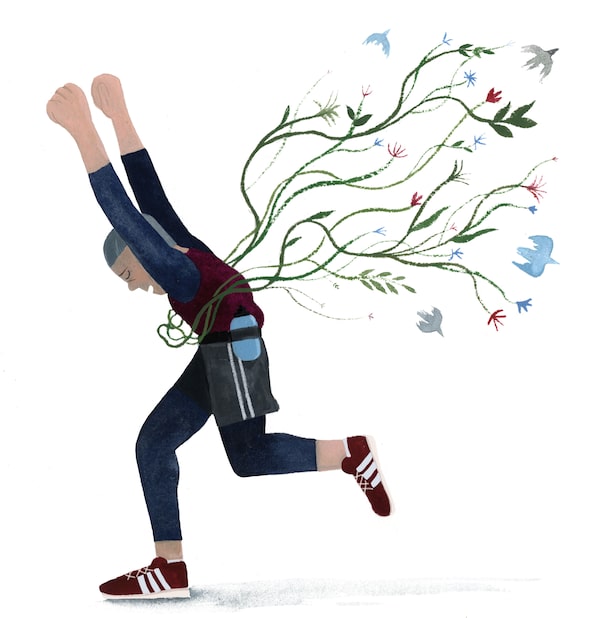
Illustration by Adam De Souza
First Person is a daily personal piece submitted by readers. Have a story to tell? See our guidelines at tgam.ca/essayguide.
The plan was crazy. I would run solo along a country road from one Saskatchewan rural locale to another. Call it a bold new challenge for a 53-year-old lifetime runner. I’d run everything else, from indoor and outdoor track to cross country, road races and a marathon. Why not this? Still, I felt oddly vulnerable at dawn, alone on a country road outside a settlement named St. Laurent. Was this starting line unease about the impending physical test? Doubt about the sanity of my running experiment? The road sign beside me read, “St. Louis 21 k.” That village, a half-marathon north through farmland and wilderness, was my finish line. With a final stretch of my legs I was off.
There’s a payoff for running at daybreak: a landscape alight in novel colours and tones. To the east the sun peeped over a high ridge turning dewy fields beneath it a shimmering gold. In the west, level farmland stretched to meet a grey, straggling fringe of dark spruce. Striding with ease, I passed bluffs, sloughs and crumbling granaries. Songbirds twittered their early morning music. I listened to my own rhythms, the tap, tap, tap of my footsteps and the coming and going of my breath. My route had everything a runner could ask for: flat stretches, elevations, shaded forest, dipping coulees.
Country roads boast interesting natural curves but tough hills. Nature isn’t levelled off like in the city and even subtle inclines, imperceptible when driving, were noticeable. Sandy gravel is my favourite running surface, though. The footing was soft and forgiving. Plunging into a steep wooded ravine, the South Saskatchewan River came into view and on it a clutch of pelicans. Next came arrow-straight stretches of flat plain beneath an endless sky. In cruise control I studied towering cloud castles and distant sun-splashed forested hills. I can also ponder the fact that movement like this is possibly the best medicine we can give ourselves. Steady, daily walking or running is possibly the greatest elixir.
Grazing cattle stared. Appaloosa ponies, surprised at the sight of another running creature, galloped alongside me. As I passed a farmstead, an aging golden retriever and a spaniel approached then retreated, tails between legs, seemingly ashamed to have barked at me. I’ve run road races with 50,000 other people. Now it’s just me and the long winding road ahead. Save for a school bus and a couple of pickups that morning, I owned the road. There’s no loneliness for this long distance runner, though. Ducks exploded into flight from ditch water. Hawks circled overhead. In a tall spruce I spotted a nesting family of bald eagles. They marked my halfway point where I was still fresh, gobbling up kilometres in a breakout run. Australian running coach Percy Cerutty believed athletes performed better when surrounded by natural beauty. Percy was onto something there.
I made my own running discovery that morning. This wasn’t cross-country running that was bringing so much bliss. Nor was it road or trail running. I’d stumbled upon a sublime new sport and was enraptured with the novelty of it. There was something unerringly pleasant, magical almost, in running free through a living countryside, past working farms and peaceful homes. Curiosity kept me wanting to discover what was over the next hill, around the next bend. Maybe I was channelling running’s roots. Steeplechasing originally meant running from one town’s church steeple to another’s.
Arthritis, bad joints and weight issues alone don’t stop baby boomers from jogging. There is societal pressure against running in later years. At the 15 k mark, the sun’s rays were intense. Then came the hill. For half an hour it had loomed large in the sun-baked distance, a high prairie mountain rising to the sky. Doubt crept in. Climbing its mile-long incline at this stage, in these steamy conditions, would be problematic.
I love hills. Dropping my head and falling into a rhythmic trance, I climbed to some gorgeous vistas. Cresting it should have left me pumped and invincible. Instead, I was shaking and wobbly. My moisture-wicking shirt, heavy on my shoulders, could wick no more moisture. Wheezing and doubled over, I ended my quest. Mission aborted. The hill finished me. Then I saw it. Below on the distant plain sat a storybook village, an oasis of mature green treetops with a church steeple poking above them. Seeing the finish line always lifts a runner. Quickly exchanging my saturated shirt for a dry one, I found my second wind. Gravity carried me gently down a three kilometre descent. Now my run was dreamlike, through a pastoral yesteryear world of old country homes, rustic corrals and picture postcard red barns. The ditches were strewn with daisies and scented with wild rose. Runner’s high kicked in. I was floating.
The last kilometres in 26 celsius heat left me flushed and bent but unbroken. My finish line beside an old school in St. Louis brought running’s unique pairing of searing pain and soaring ecstasy. Raising my arms like a Boston Marathon victor I celebrated what was possibly my Best. Run. Ever. I’d come through a transcendent experience, discovered a new world of running I didn’t know existed. Lying in a ditch, chugging water and pressing an ice pack to the back of my neck, I had my epiphany: A runner’s life really can begin at 50. My plan wasn’t so crazy after all.
Byron Jenkins lives in Saskatoon.